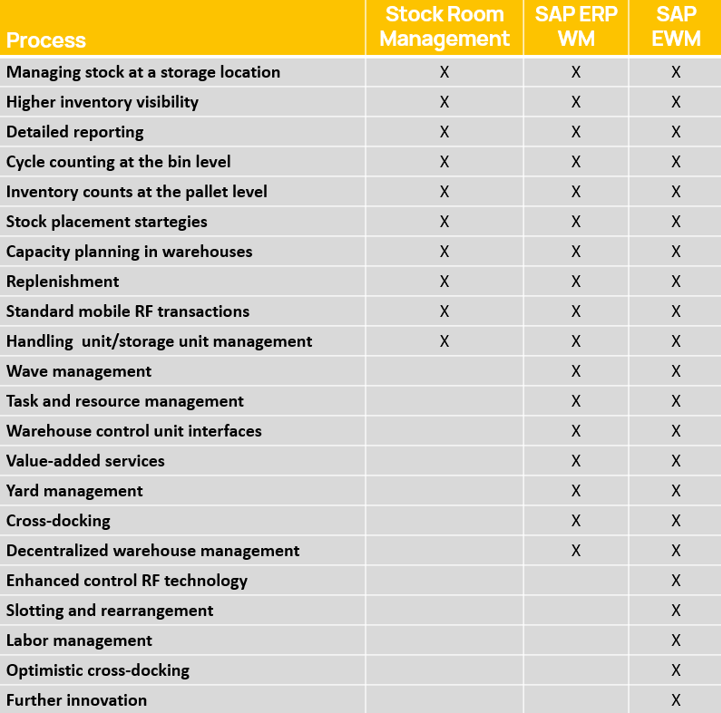In our previous article, we discussed how the end of support for SAP Business Suite and SAP WM compels companies to adopt new solutions for warehouse management in SAP S/4HANA: SAP EWM (Extended Warehouse Management).
Now, let’s delve into the differences between SAP EWM Basic and Advanced and explore four strategies for migration or implementation to help you select the most suitable path for your company's needs.
Differences between SAP EWM Basic and SAP EWM Advanced
The differences between SAP EWM Basic and other versions of EWM are significant (see SAP Note 3376453 – SAP S/4HANA 2023 FPS00, FPS01, and FPS02: Release Information and Restrictions for EWM in SAP S/4HANA).
- SAP EWM Basic is included at no additional cost in SAP S/4HANA and covers all essential warehouse logistics requirements.
- SAP EWM Advanced, on the other hand, is a sophisticated solution designed for highly automated warehouses or large-scale operations. It offers advanced functionalities such as cross-docking, real-time monitoring, and integrated resource management. For warehouses requiring high availability, it is also possible to use the decentralized version on a separate instance from SAP S/4HANA.
Four Scenarios for Migration or Implementation
1. Migration or Implementation of Stock Room Management
-
For whom? Companies utilizing basic warehouse functions without advanced automated integrations.
-
What to do? Until 2025, SAP WM can be used in compatibility mode on SAP S/4HANA; from 2026, it will be automatically converted to Stock Room Management with reduced functionalities.
-
Pros and Cons?
✅ No migration or customization required.
❌ Not an evolving solution, as SAP will not release innovations.
2. Gradual Approach with SAP EWM
-
For whom? Companies migrating to SAP S/4HANA with advanced logistics processes and SAP WM customizations.
-
What to do? After migrating to SAP S/4HANA, transition gradually to SAP EWM by choosing between the Basic or Advanced version.
-
Pros and Cons?
✅ Flexible and gradual approach.
❌ Requires alignment between SAP S/4HANA roadmap and warehouse management strategy.
3. Big-Bang Approach with SAP EWM
-
For whom? Companies with critical warehouse functionalities that will not complete migration before 2026.
-
What to do? Complete the migration to SAP S/4HANA and SAP EWM in a single phase by 2028 (or 2031 with extended support).
-
Pros and Cons?
✅ Comprehensive and future-proof solution.
❌ Requires significant resources in terms of time, budget, and personnel.
4. Gradual Approach with Decentralized SAP EWM
-
For whom? Companies looking to convert SAP WM to SAP EWM without immediately migrating to SAP S/4HANA.
-
What to do? Transition to decentralized SAP EWM while keeping the ERP on ECC until 2027 (or 2030 with extended support).
-
Pros and Cons?
✅ Enables warehouse migration independently of ERP transition.
❌ Managing two separate systems may result in higher costs.
Conclusion
The migration or implementation of SAP EWM represents a unique opportunity to prepare for future demands and leverage the possibilities offered by new technologies. Proper planning of this transition allows businesses to fully exploit the power and flexibility of SAP S/4HANA, ensuring a competitive advantage and increasingly efficient processes.
Beyond migrating from SAP WM to SAP EWM, it is also crucial to consider the migration scenarios of decentralized SAP EWM on SCM systems, which will also reach end of support by the end of 2027. For companies currently using this configuration, transitioning to SAP EWM on SAP S/4HANA is a critical step to maintaining operational continuity and benefiting from seamless integration with the central ERP system.
Contact us for a personalized consultation. Our experts will help you select the most suitable solution and guide you through the process.




.jpeg)
-1.jpeg)